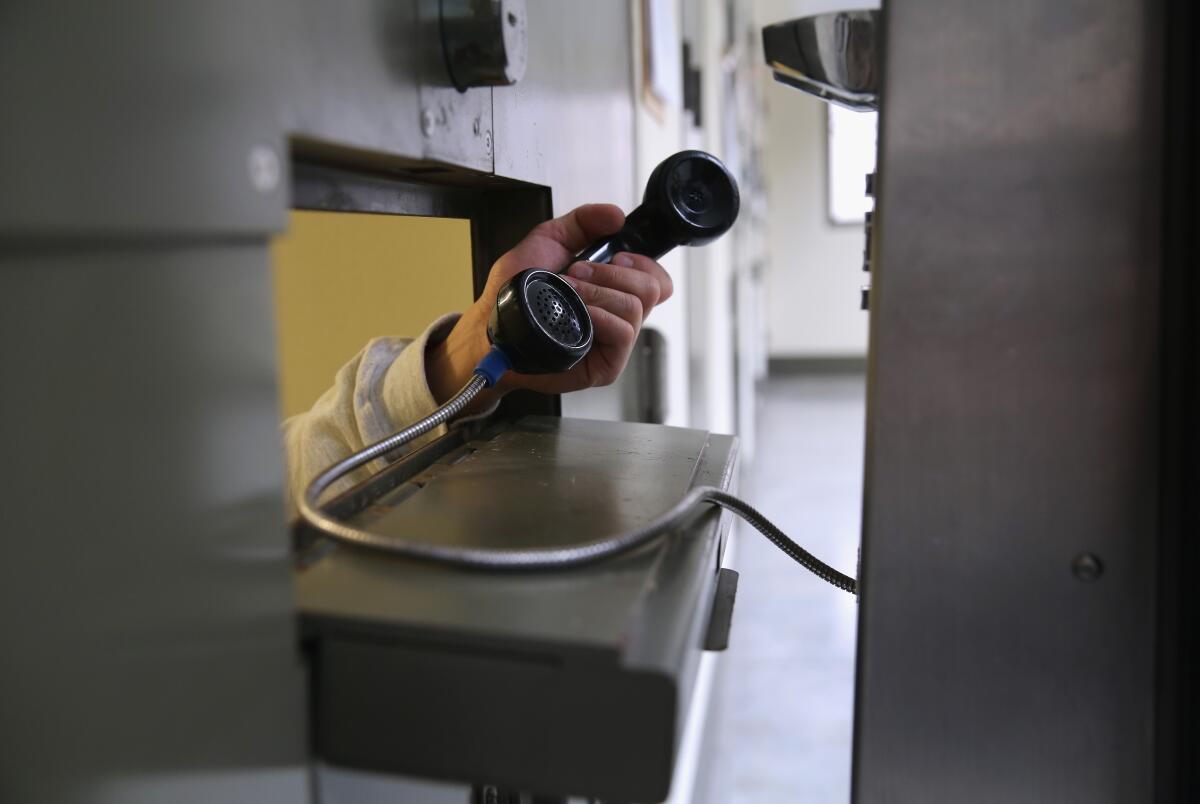Study: ICE fails to provide detainees with language interpretation required by its own rules

- Share via
WASHINGTON — A Spanish-speaking detainee at California’s McFarland immigrant detention facility was struggling in May 2023 to tell a doctor, in broken English, that he sometimes bled from his rectum.
Without calling for an interpreter or ensuring his patient understood what he was about to do, the doctor proceeded with a rectal exam that shocked and traumatized the man, he recalled in an interview with The Times.
“I was so embarrassed, powerless,” the man said, adding that he never received a diagnosis or follow-up from the doctor. “I feel it was abuse because he didn’t explain anything. I don’t understand much English.”
The man was eventually transferred to another facility, where a different doctor explained through a Spanish interpreter exactly what she would do during the exam.
His experience was one of many language-access failures documented in a report published Thursday that concluded the Immigration and Customs Enforcement agency was failing to provide adequate translation services mandated by federal law and its own rules.
U.S. Immigration and Customs Enforcement used solitary confinement more than 14,000 times from 2018 to 2023, a report found.
The report, conducted by the Kathryn O. Greenberg Immigration Justice Clinic at the Cardozo School of Law in New York, surveyed more than 200 detainees and legal service providers across the country, and reviewed more than 800 complaints from 2016 to 2022 about language-access issues. The information was provided by the Department of Homeland Security in response to federal records requests.
Most survey respondents reported never receiving language assistance at a law library and having to rely on other detainees to help translate sensitive documents.
Detainees complained of being unable to lodge requests for medical care because facility staff spoke only English, resorting to hand gestures to communicate crucial medical information. Some said they languished in pain until they were deported because they couldn’t communicate a need for care.
Legal service providers reported having clients whose medical conditions worsened because of delayed treatment caused by the lack of a suitable interpreter.
“The very nature of ICE’s language access failures makes it effectively impossible for detained individuals (who are not fluent in English) to raise, challenge, or remedy these problems on their own,” the report states.
In a statement, Immigration and Customs Enforcement spokesperson Mike Alvarez said the agency is committed to ensuring detainees have primary language access in facility programs and activities.
“The agency continuously reviews and enhances civil detention operations to ensure noncitizens are treated humanely, protected from harm, provided appropriate medical and mental healthcare, and receive the rights and protections to which they are entitled,” he wrote.
The report’s authors said the Biden administration’s new asylum rules — which seek to expedite the process — make adequate language access all the more crucial.
Unlike criminal defendants, detained immigrants generally have no right to government-appointed counsel. Because of that, language access in detention facility law libraries is essential for non-English speakers “to even understand the charges against them, much less prepare any sort of legal defense to deportation,” the report states.
Internal policies at Immigration and Customs Enforcement require detention facilities to provide detainees with interpretation for medical care and law libraries, as well as translation of written forms.
In a 2020 report, Matthew Albence, then a senior official at ICE, wrote that the agency had done “excellent work” in providing detainees with “meaningful access to programs and activities in a language they can understand.” And in March, the agency released its first Indigenous languages plan, including increasing access to vital documents through recorded messages in common Indigenous languages.
But during a review last year, Homeland Security’s Office for Civil Rights and Civil Liberties said it had received 208 allegations related to language access during the last five years, opened 116 complaint investigations and issued 118 recommendations to immigration officials regarding those violations.
Depending on whom you ask, the federal immigration app CBP One is a solution to the border crisis, a human rights violation or a ploy to let anyone into the U.S.
The problem of language access has worsened as migrants attempt to cross the border from an ever-growing diversity of countries.
Last year ICE detained migrants from 170 countries, speaking dozens of different languages, including less common ones indigenous to regions in Latin America and West Africa.
One man who speaks Soninke, a West African language, told the report’s authors that he didn’t know why he was detained at a facility in Pennsylvania — or that it was related to an immigration case — because all his documents were in English and no one at the facility understood him or provided interpretation.
Jennifer Norris, managing attorney at Immigrant Defenders Law Center in Los Angeles, said she has seen the issue permeate all steps of the legal process, from finding a lawyer to challenging arguments by the federal government in immigration court.
She said cases can stall and immigrants remain detained as immigration authorities attempt to find an appropriate interpreter.
Norris said her client Vrej, a 52-year-old Armenian speaker from Iran, was denied immigration relief during his initial court hearing, held before she began representing him. Reading the hearing transcript, she realized Vrej had been given an Armenian interpreter from Armenia who didn’t understand his dialect.
Again and again, the transcript states “Untranslated” for Vrej’s responses. Eventually, the interpreter spoke up.
“Your honor, this is the interpreter. I — I have a feeling that, uh, the respondent is not 100-percent understanding me,” the interpreter said, according to the transcript.
Vrej, who has been detained for nearly two years, appealed his denial and is now awaiting another trial.
More to Read
Get the L.A. Times Politics newsletter
Deeply reported insights into legislation, politics and policy from Sacramento, Washington and beyond. In your inbox twice per week.
You may occasionally receive promotional content from the Los Angeles Times.













